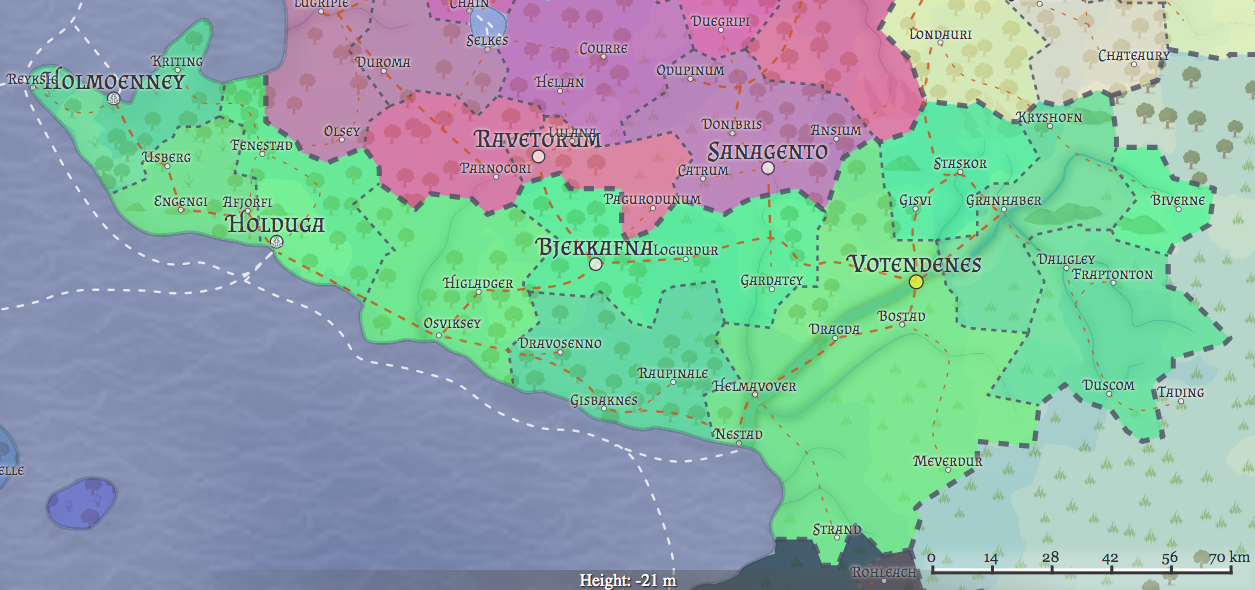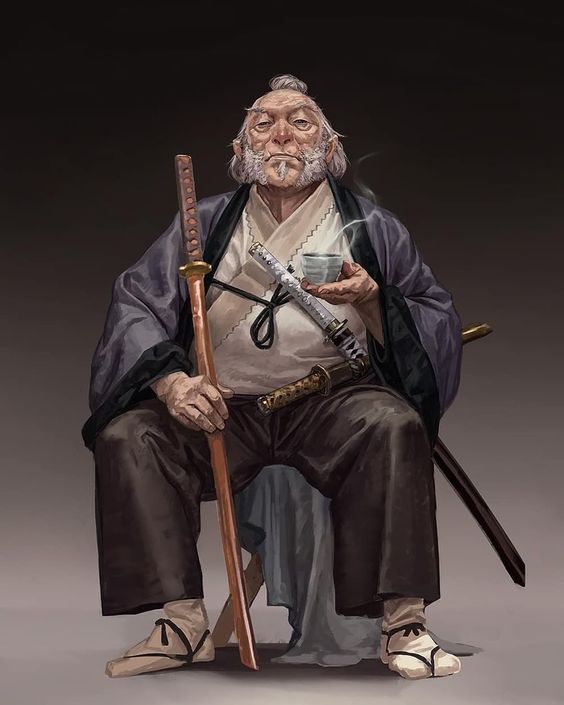The Dwarven Reach
"The Iron Wall which Guards the Jewel of the People", is how the proud dwarves would describe their nation to those who ask. The Dwarven Reach is a nation of steel, beaten and bent into its shape by a cultural mindset of absolute resolve and defense. A feudal lordship ruled by clans, daimyos, and the shogun, the nation stands as a testament to the resiliency of its people and to its strength of arms.
Structure
The Reach functions as a feudal military dictatorship, ruled from the fortress city of Votendenes. The dwarf shogun rules the bureaucracy of the Reach with sword and hammer as much as he does with paintbrushes and calligraphy. The shogun acts as the commander-in-chief for the military as well as the economic decision-maker.
Under his or her administration, a number of magistrates and administrators rule the prefectures of the nation. These governors rule as the shogun would but on a smaller scale.
There are a number of family clans that have carved various niches for themselves within the Reach.
In no particular order, there are:
- 槍馬 Yariba (Spear Horse) - Southern clan near the steppes, which act as the first line of defense against the Great Grass Sea. Headquartered in Biverne.
- 蜘蛛森 Kumomori (Spider Forest) - Northern clan near the Pax Nevarra. They are notoriously difficult to find. Headquartered in Bjekkafna.
- 青鶴 Aotsuru (Blue Crane) - Patrons of art and culture, this clan is most likely to travel to other nations. Headquartered in Holmoenney.
- 粒螳螂 Tōrōtsubu (Grain Mantis) - A naturalistic and smaller clan, yet holds the largest food production. Deeply devoted to the Tatsuyama. Headquartered in Helmavover.
- 鳳凰金 Hō-ōkin (Phoenix Gold) - Zealot followers of Pelor and Levande. Also operates numerous hospitals. Headquartered in Staskor.
- 壮獣政 Sōjusei (Magnificent Beast Government) - Old clan, followers of Zegros. Very savvy politically, with many connections to other nations. Headquartered in Holduga. Rivals of the Kanitesuwa.
- 竜山 Tatsuyama (Dragon Mountain) - The clan of the shogun. Mighty warriors, but surprisingly magically savvy. Curious about the world but also paranoid. Headquartered in Votendenes.
- 蟹鉄把 Kanitetsuwa (Crab Iron Grab) - Rules major ports. Brutal extortionists but intelligent merchants. Headquartered in Holduga. Rivals of the Sōjusei.
Culture
The people of the Dwarven Reach believe they are people under constant siege both physical and metaphorical. With the wars of conquest with the Orcs, the horrors of the Blight, the reunification, and the Warring States period, the Dwarven Reach has rarely known peace for long. The people are largely defensive by nature and are extremely wary of outsiders.
Reachers amongst themselves display this defensiveness with a culture of mutual surveillance and courtesy. Staring and declared observation is considered normal behaviour and sometimes even flattering. A signifier of climbing the social ladder is when a Reacher notices they are being spied on.
Public Agenda
The Dwarven Reach believes in security and peace for the benefit of society above all else. While they are not opposed to international trade and passable borders, they are defensive and maintain tight border security. The current shogun, Bjorn Stonefoot, has recently begun sending scholars and explorers into the Lost Kingdom for reasons unknown.
Assets
Dwarven metallurgy is extremely valuable and famous across the continent. Many rare metals and jewels are found only along the Reaches borders, granting them complete monopoly on the manufacturing of adamantium, electrum, and platinum. In addition to this, dwarves are also well-respected artists, not only in crafting, but in the fine arts as well. Painting, sculpting, and architecture are just a few examples of the dwarves' surprising grace.
One of their greatest feats is the Capital city of Votendenes, built within and on the side of the Fystcrag mountains. This architectural marvel commands a mighty view of Forlorn Valley (the valley which borders the Radiant Empire and Nevarra) and the Gates to Grasses (the mountains which overlook the Great Grass Sea).
History
The prehistory of the dwarves is old, considered to be only a little younger than the elves—though they have a more linear past. The earliest dwarven settlements are actually found along the border of the Lost Kingdom in the south. This leads to theories that the dwarves had initially migrated from the southern jungles. However, whatever history there was of that time has since been lost. Legends hold that the legendary dwarf hero, Masune The Thunder Which Shakes Mountains in Two, discovered the site which would later become Votendenes. Masune founded this site by slaying a mighty dragon and rebuilding its lair into a kingdom within the mountain's face and throat.
Since that time, the kingdom began to conquer and consolidate the disparate dwarven peoples along the Verdant Coast. They engaged in a brief war when they met the first elf sailors from the Sunset Isle. However, peace was reached relatively early on. They traded with the proto-Nevarran human cities and villages to their north and established a relatively friendly relationship. To this day, many of the northwestern prefectures of the Reach feature high human populations who are a relatively free people, able to own property and have hereditary rights.
After the 20 Year Siege of Votendenes during the Blight, a military government took over and began to spread throughout the old dwarven and human holdings to the west and north. The old dwarf freeholds and petty kingdoms fell under the great unifier, Shogun Tokki the Great and Magnanimous One.
This period, known as the Warring States Period, lasted a generation. However, through the fires and blood of war comes a new nation. Once bloodied and scarred, the dwarven people have sharpened their blades and cleaned their wounds and now are ready to march again.
Demography and Population
The Dwarven Reach has some xenophobic tendencies which has earned it some tough love from its closest allies, Nevarra and The Sunset Confederacy. It still shuns wanderers with vagrancy—a punishment worthy of a labour camp. An official government endorsement is still required, even for travelling merchants.
As such, the population stands at 97% Dwarf, 2% Human, .5% Elf, .5% Other
The Eastern Region is home to the Mountain Dwarves, who make up the majority of the warrior clans nationwide. The current ruling shogun is a Mountain Dwarf. The Western Region features the Hill Dwarve's more cunning and less brawny people, who work within the bureaucracy and the trade posts. They also tend to be friendlier and more likely to travel outside of the Reach.
Territories
The Dwarven Reach commands a narrow, but diverse, area. To its northeastern borders, it controls The Gates to the Grasses; an imposing and near impassable mountain range that overlooks the Great Grass Sea. Towards the south, it controls the rich agricultural fields which sustains much of the nation. Along the west, the Verdant Coast's fishing and stately cliffs remain an important economic region due to its shipyards, fishing communities, and geographic closeness with the Pax Nevarra. The Reach also controls the Forlorn Valley, a river valley that borders both Nevarra and The Radiant Empire.
Military
The dwarves command a fearsome military establishment. Nearly every ruling noble is a trained warrior, capable of defending themselves handily. These nobles make up a capable and educated officer corps that have years of education and training behind them. While expensive to train, they are devastating when they decide to take to the field.
The majority of dwarven warriors are drafted from serf populations. They are not extremely well trained, however, the dwarves' natural resiliency makes them formidable. They are disciplined to a fault and rarely retreat or break formation.
The truly dangerous key to the dwarven military is its secret police force that is made up of professional spies, guards, and re-educators, who are trained to eliminate threats to the state. The few foreigners allowed into the Reach will often report that if a silent watcher wasn't following their movements, they could at least feel the scrying magic watching them from afar.
Religion
The dwarves are unique among the continental nations, in that they favour a more animistic view of religion. They still worship the gods, however, they also worship hundreds if not thousands of aspects, minor gods, and spirits. To the dwarves, the act of living is a god, and it is the duty of a dwarf to worship properly. The principle of "Levande" is to live a life that benefits the community and nation as a whole. Self-sacrifice, duty, and diligence are highly respected in dwarven culture. That being said, they do have a grand temple dedicated to the gods as other nations know them. Each one is a marvel of architecture and faith. Interestingly, each god has a temple in a particular city.
Pelor, the White Flame that Dances on the Mountain Tops, is similar in many ways to the Radian interpretation of Pelor—a powerful agricultural deity that supports and fuels the principle of Levande. The White Flame is fickle however and is prone to burning droughts as often as he is to hiding coyly behind the clouds. Dwarven clerics and faithful members of the bureaucracy occasionally travel as students or guest lecturers to the College D'Sol in Godry Seic.
Hakkon Bear, Lord of Cold Breath, is a peculiar representation of the War God, as this aspect is much more mindful and patient than some other views. Rather than a berserker, Cold Breath is seen as a silent patient guardian; always mindful of the actions of others. This bear does not attack wantonly but rather studies his foes, holds his position, and strikes ferociously once approached. He is a reflection of the dwarven view of warfare, less aggressive, and with a more strategic view of conflict. That said, there are dozens of other aspects and interpretations, but the Lord of Cold Breath is the most common.
The Morrigan, The Lady of Craft. This aspect of The Morrigan is viewed as less a goddess of magic and more as a goddess of arts and crafting. The dwarves view her as a painter, smith, calligrapher, and seamstress. She is credited with introducing the dwarves to writing, art, and bureaucracy and, as such, she is worshipped more frequently by the hill dwarves and women overall.
Foreign Relations
The dwarves prefer the company of other dwarves and do not enjoy trading with other nations. However, even they acknowledge that the other races provide much that the dwarves simply cannot.
Pax Nevarrum
By dwarven standards, the Dwarven Reach is quite friendly to Nevarra. They share military interests against The Radiant Empire and have a long history of sharing burdens from the Blight. It is likely that they will continue to grow closer—so long as they both have something to point their swords at.Sunset Confederacy
To the south, The Sunset Confederacy is a necessary ally. There is much to be gained from shipping across the Shimmering Channel. From fabrics and magical materials to intellectual innovations, the two nations continue to benefit one another. However, the dwarves are wary of elven politics and are ever watchful of diplomats who sneak off in the night.The Radiant Empire
The Radiant Empire and the Dwarven Reach share a small, but strategically vital, border. The Forlorn Valley has but a single road and a small fortress city. In recent times, Radian merchants have reported many dwarven military exercises in this great valley under the distant misty eye of the shogun in his fortress mountain capital.The Lost Kingdom
For the last few years the Shogun, Bjorn Stonefoot, has begun taking a great interest in the Lost Kingdom to the south. Just what is this jungle land that that which once spawned an apocalypse? Why do monstrous humanoids continue to spew from it? And why are the elves so quiet on the matter?Agriculture & Industry
The Reach is well known for agricultural and industrial complexes. Firstly, food, while plentiful, is also tightly controlled by the government. The Taford River is remarkably reliable, with its yearly cycles allowing for the regulated and steady production of grains and rice. Harvests are regular and bountiful but will be quickly seized and controlled by government magistrates for redistribution to other prefectures of the Reach. Animal Husbandry is also abundant, with horses, sheep, and pigs being common staples of food and as beasts of burden.
Where the Reach truly shines is its metal production. Many of Amastris's rarest metals are found in the Dwarven Reach, either in the Gates to the Grasses or along the Verdant Coast. Dwarves frequently incorporate metal into structures, clothing, and art. While gold is mined for currency purposes, dwarves don't hold it to a high standard, as they have adamantium, platinum, and electrum for more extravagant purposes. Metal is often seen as a form of rank or status—the rarer the metal you wear, the higher your rank.
Political Influence & Intrigue
The dwarves are fond of incorporating metal into rank and status structures; as befitting such a stratified society. Typically, dwarves will wear items made with metals in order to discern at a glance what the rank of others are.
From lowest to highest:
- Copper: Versatile and useful, but easy to mine. Someone wearing this metal belongs amongst the lowest classes. Farmers, woodworkers, and cattle ranchers are some examples.
- Iron: Strong, reliable, and the foundation of many alloys. Iron represents common soldiers, young smiths, and craftsmen.
- Gold: Rare enough that it's not bountiful, but also soft and malleable. Merchants, bureaucrats, and non-noble officers wear gold regularly.
- Platinum: Rare, resistant to corruption, and tougher than gold; only those of true noble birth are entitled to wear this precious metal. Anyone of noble birth may wear this metal regardless of their occupation. Even disgraced and shamed criminals are allowed to wear this metal, though few would sell the metal to them.
- Adamantium: Only the daiymos and the shogun are allowed to wear this luxurious and unbreakable metal. They will wear either suits of armour made of the metal or carry weapons crafted from the metal. These are treasured and priceless heirlooms. To carry this metal undeservedly is a capital offence, and a swift execution will soon follow.

The Iron Wall
Founding Date
78 Dawn
Type
Geopolitical, Lordship
Training Level
Semi-professional
Veterancy Level
Trained
Demonym
Reacher
Government System
Stratocracy
Power Structure
Unitary state
Economic System
Market economy
Deities
Neighboring Nations
Notable Members
Related Species
Related Ethnicities
A dwarf boble sits and enjoys his warmed ale
Remove these ads. Join the Worldbuilders Guild










Comments